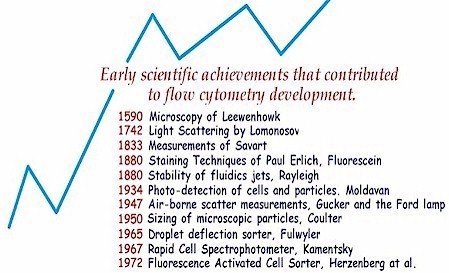
About Flow Cytometry |
||

|
|
||||||
A Brief History of Flow CytometryMany early breakthroughs in science contributed to the development of flow cytometry.
In 1972, Dr. Len Herzenberg's group at Stanford University designed and patented a fluorescence activated cell sorter (FACS). In 1974, Becton Dickinson, Inc. licensed Stanford University's FACS technology and introduced the first commercial flow cytometer, which was called the FACS-1. It was followed in 1977 by the System 50 Cytofluorograph, developed by Ortho Diagnostics, Inc. During the late 1970's, Los Alamos National Laboratories (LANL) developed multi-parameter capability for flow cytometers. This was incorporated into the commercial flow cytometers designed by Coulter Electronics, Inc. and resulted in the introduction of the Two-Parameter Sorter (TPS-1). During the early 1980's, Dr. Joe Gray's team at the Lawrence Livermore National Laboratories (LLNL) built a high-speed flow cytometer and successfully used it to sort human chromosomes as part of the Human Genome Project. By the end of the 1980's, Becton Dickinson's FACScan and Coulter's EPICS Profile flow cytometers had become industry-standard commercial cell analyzers. Then, in 1994, Cytomation introduced the MoFlo® cytometer, a commercial version of the high-speed cell sorter developed by Dr. Ger van den Engh and his colleagues at LLNL. This system increased the sorting speeds of commercially available sorters from 5,000 cells per second to 50,000+ cells per second. Today, new applications for flow cytometers require specialized features and functions. As flow cytometers are enhanced to meet these needs, the potential for use in research continues to grow, ensuring the future of the science of flow cytometry in both the academic and commercial research communities. |